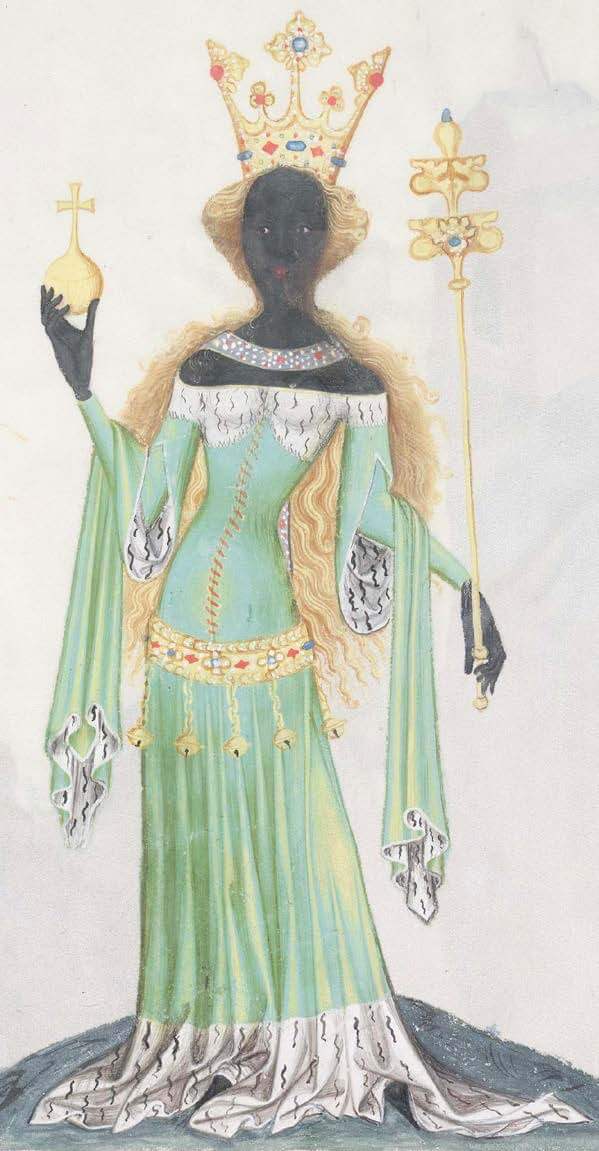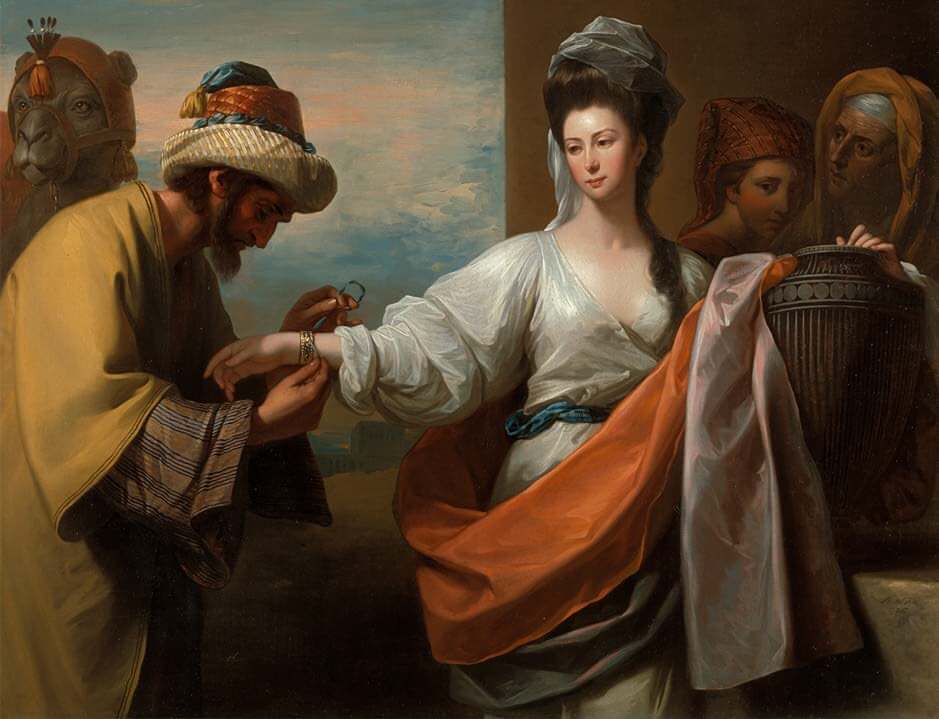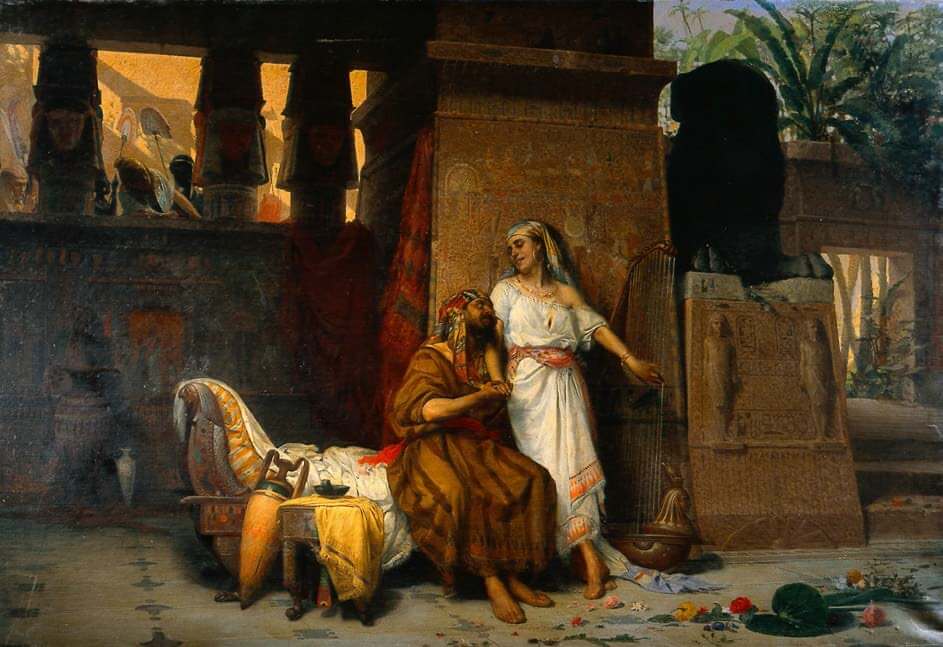Above: Ken Goldman. Jacob’s Ladder Triptych, 2015. Chromaluxe print after performance. Photos by Gideon Cohen
While COVID-19 has forced many of us to reconsider our access and relation to travel, the world today continues to be filled with a range of mobilities. Yet we are far from the first movers—or stayers—as people, objects, and ideas have always been on the move, though not with equal prospects. Ancient Israel is not an exception in this regard, even if the remaining evidence for mobility in that context remains limited and leaves many questions unanswered.
The idea of the Hebrews as a wandering people is central to the social memory of Judaism: the patriarchs and their families move from Mesopotamia to Canaan to Egypt, and the Exodus sets in motion a long journey to the land promised by the God of Israel to his people. The Babylonian exile narrates a forced migration away from that land. In addition, people move in biblical texts because of slavery, trade, warfare, famines, family life, festivals, and education. These movers are often men but also include a surprising number of women whose journeys are both voluntary and involuntary, enabled by privileges or forced by inequalities. These stories deserve to be heard, not least because of the ways in which they can both illuminate and challenge contemporary notions of travel.i

The Queen of Sheba, as depicted in Konrad Kyeser von Eichstadt’s Bellifortis, c.1405. Staats- und Universitätsbibliothek Göttingen, 2 Cod. Ms. Philos. 63, Cim., fol. 122r.
The question of who actually moves in the Hebrew Bible is a crucial one. After all, elite men produced the texts, and only a small portion of the named figures are women. Furthermore, travel requires both material and social resources, and many forms of mobility are tied to one’s position in society. It is thus necessary to have a careful look at the profiles of travelers as well as the motives behind the travelers’ trips, that is, the complex social realities that prompted, enabled, or forced their movement.
A great deal of long-distance mobility in antiquity revolved around military service, trade, and political journeys. The evidence for female activity in these spheres of life is limited, which suggests that many movers in ancient Israel were men. Yet these mobilities also affected women. First, warfare involved forced displacement of female captives as sexual property and symbols of conquest (Deut. 21). Second, women contributed to the economic system as producers of exports and moved for business reasons, at least locally (Tob. 2). Third, the story about the Queen of Sheba (1 Kgs 10) highlights the prospects of influential women in the management of foreign relations.

Benjamin West. Rebecca Receiving the Bracelet at the Well, 1775. Oil on canvas. 48.75 in. by 63.2 in. Yale Center for British Art, Paul Mellon Collection
Though many of those who undertook military, business, or political trips were men, it should be stressed that long-distance travel was also rare to the majority of men. But movement is not just about major journeys. The lack of long-distance travel does not mean that ancient lives would have been immobile. Regional and local trips, too, may shape travelers and those related to them. They may affect, for example, one’s familial status, socioeconomic position, or identification with a group.
In fact, I argue that the gendered aspect of travel in ancient Israel looks quite different if one looks beyond military, trade-related, and political mobility—all forms of travel that are relevant to traditional history writing but leave out much of human experience in the past. A close reading of biblical texts indicates a range of reasons why women moved or had to move.

Muzzioli Giovanni. Abraham and Sarah at the Pharaoh’s Court, 1875. Oil on canvas. 45.4 in. by 65.7 in. Pugnaghi/Museo Civico di Modena
Forms of slavery, to begin with, caused forced or otherwise undesirable movement. I have already mentioned the displacement of captives (Deut. 21). Biblical narratives also mention the sex trafficking of young girls (Esth. 2) and draw attention to the vulnerability of female slaves. Hagar is portrayed as a wayfaring alien who is dependent on her masters’ goodwill and experiences both escape and expulsion (Gen. 16; 21). The Levite’s concubine (Judg. 19) takes initiative to move between the house of her master and her childhood home but encounters a tragic end when the habits of hospitality protect her master at her expense.
Free women hail from diverse contexts that both enable and force movement. Given that travel requires resources, one might expect that unenslaved female travelers belong to the elite. Yet privileged positions are not overrepresented in the biblical accounts, and the majority of women’s journeys concern members of the middle strata of ancient Israelite society.
Marriage arrangements are a common reason for female mobility. Brides have to relocate because of their reproductive capital, that is, to continue the desired lineage. While women such as Rebekah are depicted as willing to move (Gen. 24), men strike deals concerning their future. Rebekah also moves with her maids, which alleviates her pain but may be undesirable to those moving with her. In addition, the stories about traveling brides and wives stress the value of farewell: a departure should not be abrupt but accompanied by music and kisses (Gen. 31) or blessings and instruction (Tob. 10).
Both women and men move as pilgrims and economic migrants. First, social and religious concerns intersect in pilgrimage. It seems voluntary but was probably driven by social expectations, which makes it difficult to estimate the extent to which it was voluntary. In any event, pilgrimage is depicted as a relatively universal practice, though the biblical laws are ambiguous regarding the wife’s obligations (Deut. 16). Furthermore, women of reproductive age are associated with visits to sacred places in the hope of pregnancy (1 Sam. 1), or to offer sacrifices after giving birth (Lev. 12). Some women probably brought sacrifices to the Temple because of their Nazirite vows (Num. 6).
Second, environmental reasons prompt economic migration. In Genesis, the patriarchs move around because of famines, including but not limited to the story about Sarai and Abram in Egypt, in which Sarai is exposed to a type of sex work in the Pharaoh’s court (Gen. 12). In the book of Ruth, the Moabite protagonist follows her mother-in-law to Bethlehem, adopts Naomi’s elohim, and ends up working in Boaz’s fields as a foreign laborer exposed to gendered sexual violence. Both Sarai and Ruth are told to commit sexual deeds with foreign men to gain economic security.
In sum, forms of travel in ancient Israel were as complex as the society in general. Some people could move because of privileges, but many found themselves on the road because of social disadvantages and lack of power. Class matters but does not explain everything, as a number of factors—one’s position in the patriarchal family, religious laws, oppressive ideologies, and interpersonal interactions—influence the movers’ agency and experiences, for better or worse.

Photo by Lars Svankjær/ Videnskabernes Selskab
Elisa Uusimäki is associate professor in Hebrew Bible at Aarhus University, Denmark. This essay is based on her article “An Intersectional Perspective on Female Mobility in the Hebrew Bible,” to be published in the journal Vetus Testamentum (doi: 10.1163/15685330-bja10084), enabled by the European Research Council grant 948264 (ANINAN).
i To be sure, a great deal of the biblical material on human mobility is fictive and imaginary, i.e., not traditional archival sources used in history. While the material does not provide us with access to specific events or figures in the past, it contains valuable documents of cultural history. Given that the authors drew on their own experiences and knowledge of the world in composing them, the sources echo aspects of social life in antiquity and may provide more personal insights into history.